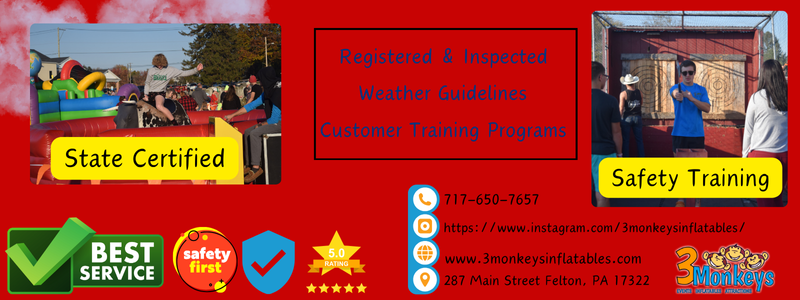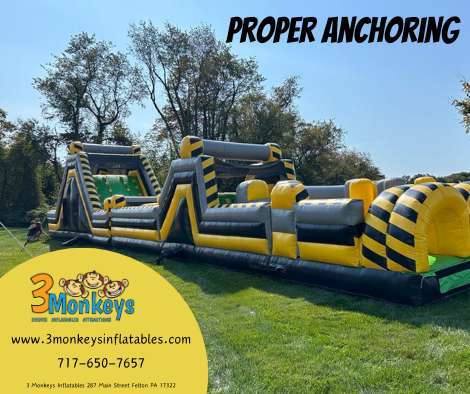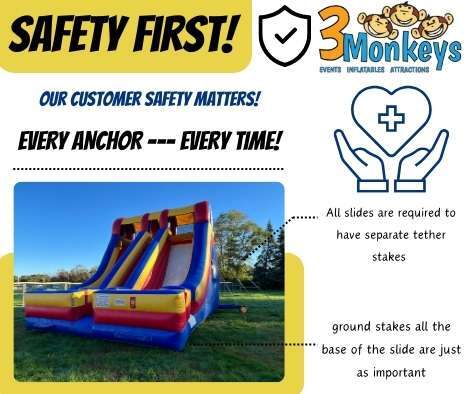The Importance of Bounce House Safety for Events

State Inspections and Safety Certifications
Bounce houses should be state-inspected and certified to meet local safety regulations. This ensures that the inflatable is safe for public use and regularly maintained. When renting a bounce house, always ask if the equipment has passed inspection.
At 3 Monkeys Inflatables, all of our bounce houses are state-approved and inspected for safety. We maintain our equipment to the highest standards, ensuring a safe and fun experience at every event.
Understanding PA and MD Safety Programs
In Pennsylvania and Maryland, safety is a top priority when it comes to amusement rides and inflatables, and this extends to our business at 3 Monkeys Inflatables. Both states have strict regulations that require bounce houses and other inflatable attractions to be regularly inspected and certified. These state programs are crucial in ensuring the safety of our equipment and the well-being of our customers.
In Pennsylvania, the Amusement Rides and Attractions Program regulates and inspects amusement rides and inflatables to ensure they meet stringent safety standards. This program ensures that inflatables are inspected for structural integrity, proper anchoring, and overall safety before they are allowed for public use.
Similarly, Maryland’s Amusement Ride Safety Program provides comprehensive safety oversight, ensuring that all inflatables and amusement rides are regularly inspected and maintained according to state guidelines.
For us at 3 Monkeys Inflatables, these safety programs are essential, not only to meet regulatory requirements but also to provide peace of mind to our customers. By adhering to these rigorous state safety standards, we can ensure that every bounce house rental is safe, secure, and enjoyable for everyone. It’s a vital part of how we help keep our customers safe at every event we serve.
FAQ: What does it mean when a bounce house is state-certified?
Answer: State-certified means that the inflatable has passed official safety inspections required by the state. These inspections check for structural integrity, proper anchoring systems, and overall safety.

Proper Setup and Anchoring
One of the most important aspects of bounce house safety is proper setup and anchoring. A bounce house that isn’t securely anchored can shift or collapse, leading to serious accidents. Your rental company should handle the setup and anchoring to ensure it is done correctly.
In both Pennsylvania and Maryland, it is required that all inflatables be anchored using 18-inch stakes or heavy sandbags to ensure stability. This helps to prevent the inflatable from moving, especially in outdoor environments where wind or uneven terrain can affect its stability. At 3 Monkeys Inflatables, we strictly adhere to these safety regulations. Whether we’re setting up on grass or hard surfaces, we use appropriate anchoring methods based on the environment to ensure the bounce house remains secure throughout the event.
In addition to the proper setup, it’s important to monitor weather conditions. If winds exceed 15-20 mph, we instruct our clients to shut down the inflatable immediately. High winds pose a significant risk to the structural stability of the bounce house, and we prioritize safety by taking proactive steps to avoid accidents. We provide clear guidelines for shutting down the equipment when wind speeds become unsafe.
At 3 Monkeys Inflatables, we take care of the setup for you, making sure that each inflatable is securely anchored using stakes or sandbags, depending on the surface. We also provide detailed customer training programs to help you monitor the inflatable during your event. This includes instructyions on wind safety, weather precautions, and the correct process for shutting down the inflatable if needed, so there is no guess work, just safety documentation to ensure there is a weather plan.
FAQ: How are bounce houses anchored for safety?
Answer: Bounce houses are anchored using 18-inch metal stakes or 50-lb sandbags to prevent them from moving or tipping over. Proper anchoring is essential, especially in outdoor settings where weather can affect stability. Keeping track of weather conditions also is part of safety. If wind speeds exceed 15-20 mph, we recommend immediately shutting down the inflatable to ensure safety. The metal stakes and sandbags are not to take place of common sense. When the weather changes, you should consult your weather plan left for you by the company you work with so that you are prepared and know exactly what to do. 3 Monkeys Inflatables also has an emergency number open all hours of the day/night to take emergency calls, so we take the guess work out of safety.
Supervision is Key
A bounce house should never be left unsupervised. Proper supervision is crucial to ensuring that all participants use the inflatable safely and responsibly. It’s important to have an adult or trained staff member monitoring the inflatable at all times to prevent overcrowding, rough play, or any unsafe behavior.
At 3 Monkeys Inflatables, we emphasize that supervision goes beyond just watching the inflatable. The supervisor, or “lifeguard” of the unit, should be a responsible adult who understands the safety rules and can enforce them during the event. According to both 3 Monkeys Inflatables and the PA Ride Safety Division, the designated supervisor must be at least 16 years old and should have read the safety guidelines for that particular inflatable. This person should fully understand how the inflatable operates, including weight limits, proper usage, and how to address potential hazards.
The supervisor's role is to act as the lifeguard of the inflatable, ensuring the safety of all participants. They must prevent overcrowding, ensure that only the appropriate number of children are inside the bounce house, and stop any rough or unsafe play. It’s also important for the supervisor to understand when the inflatable should be temporarily shut down—for example, if weather conditions change or if participants are not following the rules.
If there is no adult present who understands the safety rules and can monitor the bounce house properly, the inflatable should be deflated and not used until a responsible supervisor is available. Leaving an unsupervised inflatable in operation increases the risk of accidents, injuries, or damage to the equipment.
FAQ: Do I need to supervise the bounce house during my event?
Answer: Yes, supervision is critical. An adult, 16 years or older, must be present to monitor the bounce house and ensure that the number of participants does not exceed the safe limit. At 3 Monkeys Inflatables, and in agreement with PA Ride Safety Division, the designated supervisor should have read the safety rules and fully understand how to operate the inflatable based on the safety regulations for that specific unit. If no one is available to supervise the inflatable, it should be deflated and not used until proper supervision is in place.

Weather Considerations for Safety
Weather conditions can directly impact the safety of bounce houses, making it critical to monitor forecasts and follow specific guidelines. High winds, heavy rain, and lightning are particularly dangerous for inflatables, and operators must be prepared to shut down the equipment if the weather becomes unsafe.
At 3 Monkeys Inflatables, we follow strict weather protocols to ensure the safety of our customers. These protocols are based on industry best practices and state regulations in Pennsylvania and Maryland.
Wind Conditions
Wind poses one of the most significant risks to bounce house stability. According to the Beaufort Wind Scale, bounce houses should not operate in winds exceeding 15-20 mph, and larger inflatables like slides should be shut down at 15 mph. Here are some key guidelines to follow based on the conditions outside:
- 0-3 mph (Calm): Conditions are safe. No action is needed.
- 4-7 mph (Leaves Rustle): Continue monitoring the weather closely.
- 8-12 mph (Leaves and Twigs in Motion): Be on alert and prepare for potential shutdown.
- 13-18 mph (Dust Starts Flying): DEFALTE the bounce house immediately, as these conditions are unsafe for operation.
- 19-24 mph (Small Trees Sway): All inflatables should be deflated. Conditions are highly dangerous.
On windy days, we also ensure that all inflatables are double anchored—using both 18-inch stakes and sandbags for maximum stability. PA Ride Safety Division and Maryland’s Amusement Ride Safety Program require that inflatables are properly anchored at all times to prevent movement in high winds.
Thunder and Lightning
We follow the 30/30 Rule to ensure safety during thunderstorms:
- If you see lightning or hear thunder, operations must be stopped immediately.
- Wait 30 minutes after the last sound of thunder or sight of lightning before resuming use of the bounce house. This ensures that the storm has safely passed and there is no risk of a lightning strike.
What to Do If Conditions Change
Our team at 3 Monkeys Inflatables provides training programs for event supervisors and volunteers to help monitor the weather and make quick decisions. Supervisors are instructed to keep a vigilant eye on the sky and winds. If in doubt, it's always better to remove all participants from the inflatable and shut it down.
FAQ: Can bounce houses be used in bad weather?
Answer: No, bounce houses should never be used in high winds, heavy rain, or thunderstorms. If winds exceed 15-20 mph, inflatables must be deflated immediately. Following the Beaufort Wind Scale, any sign of unsafe weather conditions should lead to shutting down the inflatable for safety reasons. Keep an eye for bad weather and setup an alert system to other volunteers so you are together in shutting down if weather changes suddenly.
Licensed and Insured Companies Are a Must
When renting a bounce house or any inflatable, working with a licensed and insured company is essential for your safety and peace of mind. These certifications guarantee that the rental provider follows industry standards and complies with state regulations, including proper equipment maintenance, safe installation, and supervision. In case of accidents or equipment malfunction, licensed and insured companies have the necessary coverage to protect both themselves and their customers.
Why is Licensing Important?
Licensing ensures that the rental company is approved to operate by state authorities and has undergone the required safety inspections for their equipment. Both Pennsylvania and Maryland have strict requirements for amusement ride operators, which include inflatables. For example, the PA Amusement Rides and Attractions Program mandates regular inspections and certifications to ensure that all equipment is safe for public use. Similarly, Maryland’s Amusement Ride Safety Program enforces strict safety regulations, requiring that all inflatables pass inspection before they can be rented out.
By renting from a licensed company like 3 Monkeys Inflatables, you can trust that every inflatable has passed rigorous inspections and meets the state’s highest safety standards. This protects not only your guests but also the event host from liability if anything goes wrong.
The Importance of Insurance
In addition to licensing, insurance is a non-negotiable factor when choosing a rental company. Accidents, while rare, can happen, and insurance provides a crucial safety net. If someone is injured or if property is damaged, an insured company will cover the costs, protecting you from financial liability. However, it’s important to remember that insurance coverage applies only when equipment is used properly and according to the provided safety guidelines.
At 3 Monkeys Inflatables, we carry comprehensive liability insurance that covers any potential accidents during the rental period. However, while we handle the setup and provide detailed safety instructions, you and your guests are the first line of defense when operating the inflatables. By following our safety guidelines and ensuring that the inflatables are used responsibly, you help ensure that the equipment remains safe for everyone. Our insurance covers you as long as the equipment is being used as instructed, and participants follow all safety rules.
Real-World Scenarios
- Damage to the Equipment: If damage occurs to the inflatable (e.g., tears, punctures, or malfunctions), it’s important that you follow the proper shutdown procedures and notify us immediately. As the first line of defense, it’s your responsibility to monitor the equipment while it’s in your care. Our insurance will cover repairs as long as the equipment was used in accordance with our guidelines.
- Accidents or Injuries: In the event of an injury, we expect the supervising adult to act quickly by following safety protocols, removing participants from the inflatable, and contacting us. Our insurance will take over as long as safety rules were followed and the equipment was used properly. You can trust that we’ll work directly with our insurance provider to ensure any issues are handled professionally.
Why 3 Monkeys Inflatables?
At 3 Monkeys Inflatables, we not only provide licensed and insured equipment, but we also empower our customers to be responsible operators of the inflatables. We offer training programs to ensure you understand how to properly supervise the bounce house and what to do in case of an emergency. Clear communication and adherence to our safety guidelines help ensure that your event runs smoothly.
While our insurance covers you, your role as the first line of offense in ensuring the safe use of inflatables is critical. As long as you follow the rules, monitor the equipment, and ensure proper supervision, you can be confident that both you and your guests are fully protected.
FAQ: Why should I rent from a licensed and insured company?
Answer: Renting from a licensed and insured company ensures that the bounce house meets state safety standards and that you’re protected in case of accidents or damage. However, insurance only applies when equipment is used properly and safety guidelines are followed. At 3 Monkeys Inflatables, we provide all the resources you need to keep your event safe and ensure everyone has a great time.
Glossary of Terms for The Importance of Bounce House Safety for Events
State-Approved: Refers to bounce houses that have passed mandatory safety inspections and are certified by state authorities as safe for public use.
Anchoring: The process of securely fastening the bounce house to the ground using stakes or sandbags to prevent movement or tipping during use.
Supervision: The requirement for an adult or trained individual to monitor the use of the bounce house to ensure that participants are following safety rules and to prevent accidents.
Beaufort Wind Scale: A scale used to measure wind speed and its effects on objects, which is important in determining when inflatables must be deflated for safety.
30/30 Rule: A guideline followed during thunderstorms, where activities must cease if lightning is seen or thunder is heard, and operations may only resume 30 minutes after the last sight of lightning or sound of thunder.
Double Anchoring: Using both stakes and sandbags to secure an inflatable for added stability in outdoor environments, particularly when weather conditions could pose a risk.
Weather Policy: A set of safety rules outlining how to respond to weather conditions like wind, rain, and thunderstorms, which dictate when to shut down inflatables for safety.
Licensed and Insured: Describes companies that are officially authorized to operate under state regulations and carry insurance to protect against liabilities in the event of accidents or damages.
Liability Insurance: A type of insurance that covers the costs of accidents, injuries, or damage to property, protecting both the rental company and the event organizer.
Safety Guidelines: A set of instructions provided to customers and supervisors about how to properly operate and monitor bounce houses to ensure safe use.
First Line of Defense: A term used to describe the responsibility of the customer to monitor and supervise the bounce house to prevent accidents while in their care.
Deflation: The process of removing air from an inflatable device, typically done when weather conditions make continued use unsafe, such as in high winds or thunderstorms.
Customer Training Programs: Instructional materials provided by the rental company to help customers and event supervisors understand how to safely use and monitor inflatables.
Wind Conditions: Environmental factors related to wind speed, which must be monitored to ensure the safety of bounce houses and other inflatables during an event.
Inflatable: Refers to the bounce house or other inflatable equipment used for entertainment, which requires proper setup, supervision, and safety protocols to operate safely.
